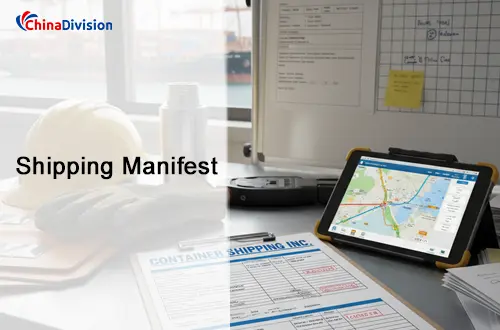Understanding the Shipping Manifest: A Pitfall-Avoiding Guide
Before every major ship sets sail, a crucial "digital passport" must be prepared—the shipping manifest. For B2B businesses and e-commerce sellers, understanding the shipping manifest is not only essential for compliance but also crucial for ensuring smooth and on-time delivery of goods. Whether you're shipping by sea, air, or land, a well-prepared shipping manifest ensures compliance, avoids delays, and keeps your supply chain running smoothly.
Table of Contents
As your professional international freight transport service partner, Chinadivision understands your concerns and pain points regarding documentation. This article provides an in-depth analysis of the shipping manifest, answers common questions, and demonstrates how Chinadivision can simplify it all.
The Importance of the Ocean Manifest
A marine manifest, or manifest for short, is an official document compiled by a carrier (shipping company) or freight forwarder that details all cargo loaded on a vessel, aircraft, or truck. You might think of it as a giant "packing list" or "cargo list," but it carries legal weight and serves as the core basis for customs and port authorities to conduct inspections, risk assessments, and cargo tracking.

Its importance lies in three key areas:
The cornerstone of customs clearance
Customs uses manifest data to conduct advance security assessments and decide whether to inspect cargo. Incorrect or missing manifests can lead to customs clearance delays, hefty fines, or even rejection of cargo.
The roadmap for cargo tracking
Information such as the bill of lading number and container number are recorded on the manifest, providing the basis for you and all relevant parties to track the status of your cargo.
An assurance of safety and compliance
Especially for dangerous goods, an accurate dangerous goods manifest ensures that shippers take appropriate measures to protect the safety of the vessel, personnel, and the environment.
The Main Purpose of a Freight Manifest
Customs and Port Authorities: Verify declared cargo against actual shipment, assess duties and taxes, and identify any restricted or prohibited items.
Logistics and Operations: Facilitate the efficient loading, unloading, and tracking of cargo from origin to destination.
Safety and Security: Provide critical information, particularly regarding hazardous materials, to ensure crew safety and for use in emergency situations.
What Types of Freight Manifests are There?
Not all manifests are created equal. Depending on the mode of transport and type of cargo, the most common manifest forms are as follows:
- Cargo Manifest (General)
Used for all types of transport (air, ocean, road). Lists all cargo, including shipper/consignee details, weight, and description.
- Container Manifest (Ocean)
Specific to container transport. A container manifest focuses on information such as the contents of each container, including serial number, weight, bill of lading number, and more. It details the contents of each container, including seal numbers and container IDs.
- Bill of Lading (B/L) Manifest (Ocean Shipping)
A Sea Manifest records the detailed information of all containers or cargo on board a vessel, grouped by port of destination. It typically accompanies the Master's Bill of Lading (MBL) or the Head's Bill of Lading (HBL). It summarizes all bills of lading for a single shipment.
Master Manifest: Prepared by the shipping company, it covers all cargo on board the vessel.
House Manifest: Prepared by a freight forwarder (such as Chinadivision), it lists all cargo for its clients and is a component of the Master Manifest.
- Dangerous Goods Manifest (Dangerous Goods Transport)
A Dangerous Goods Manifest specifically records the classification, UN number, and handling instructions for dangerous goods, in accordance with IMO or IATA regulations. This manifest lists the dangerous goods on board, and its format and content are strictly regulated. It is required for shipments containing dangerous goods (such as chemicals or batteries). It includes the UN number, classification code, and emergency contact information.
- Air Waybill (AWB) Manifest (Air Freight)
Similar to a cargo manifest, but specifically for air freight. It lists all AWBs for a single flight.
- Customs Manifest (Entry Summary)
A simplified version of the manifest provides an overview of the cargo for quick reference. It is submitted to customs authorities for customs clearance. It includes value, origin, and duties/taxes.
Key elements of a cargo manifest
Shipper and consignee information (name, address, contact information)
Cargo description (type, quantity, weight, dimensions)
Container/seal number (ocean freight) (core of a container manifest, including container number, seal number, container type, and quantity)
Bill of Lading/Airway Bill number (Master Bill of Lading (MBL) and House Bill of Lading (HBL))
Port of Loading and Port of Discharge (cargo origin and destination ports)
Vessel/flight details (name, voyage number, ETA/ETD)
Special handling instructions (refrigerated temperature, dangerous goods symbol)
Customs declaration (HS Code, Value, Country of Origin
Dangerous Goods Information (if applicable): UN number, dangerous goods class, correct shipping name, etc. are mandatory requirements for dangerous goods manifests.
This information is not only used for customs clearance but also helps transport companies avoid misloading and missing shipments, improving supply chain efficiency.
What happens if the manifest is incomplete or incorrect?
Unable to clear customs at the destination port: The goods will be detained by customs upon arrival.
High costs: These include manifest modification fees, port demurrage, and storage fees.
Severe delivery delays: The modification process can cause goods to be held up for weeks.
Significant delivery delays: In the worst case, the entire shipment may be returned to the port of origin or confiscated due to inaccurate information.
Be sure to carefully review detailed information such as the customs code, weight, and consignee information.
Common User Pain Points and FAQs
Is a separate dangerous goods manifest required?
Yes! Dangerous goods shipments require a Dangerous Goods Declaration Form. (DGD) and a dedicated manifest. Failure to comply can result in severe penalties.
Who is responsible for preparing the shipping manifest?
Typically, the carrier or freight forwarder prepares and submits the manifest. However, the accuracy of the manifest depends on the cargo information provided by the shipper to the freight forwarder.
How does a container manifest differ from a cargo manifest?
A container manifest focuses solely on the containerized cargo, listing the seal number and container ID. A cargo manifest is broader, covering all types of cargo.
What is the difference between a manifest and a packing list?
A packing list details the contents of each package, while a manifest summarizes all cargo on a vessel/flight. Both are required for customs clearance.
Can manifest information be modified after it has been submitted?
Yes, but the process is complex and can incur significant fees (often referred to as an "AMS/ISF Amendment Fee"). Customs in various countries have strict amendment deadlines (for example, the US AMS requires submission 24 hours before departure, making modifications very difficult). Therefore, it is crucial to provide 100% accurate information the first time.
Chinadivision How to Simplify Manifest Management?
You don't have to navigate the complexities of manifest regulations and international shipping processes alone. Chinadivision, a professional international freight forwarding service provider, offers:
Professional Compliance Assurance
Our team of experts is deeply familiar with global customs manifest regulations, ensuring every declaration is accurate and accurate, avoiding fines and delays.
One-Stop Solutions
From booking, customs declaration, document preparation, to shipment tracking, we provide door-to-door services, allowing you to resolve all your issues with a single point of contact.
E-Commerce Exclusive Services
We understand the unique needs of e-commerce sellers and offer flexible consolidation, overseas warehousing, and drop shipping services, integrating efficiently with your e-commerce platform's ordering system.
Transparent Tracking
Our system allows you to track your shipment status in real time, including manifest submission confirmation, for complete control.
At Chinadivision, we do more than just provide freight booking services. We serve as your dedicated partner, meticulously managing your freight manifests and all other documentation. Our goal is to handle the complexities of international logistics, allowing you to focus on growing your business. Don't let manifest errors hinder your global trade. Contact Chinadivision today for a free consultation to learn how our end-to-end logistics solutions can streamline your international shipping process.





